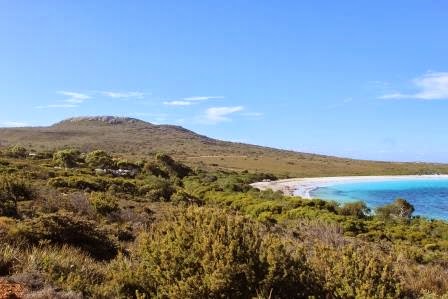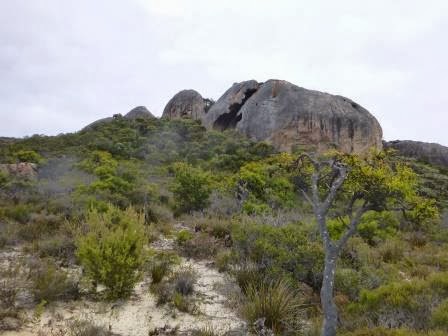Saturday March 1
As planned, we drove 80km west to Stokes National Park on
Thursday and were thrilled to see properties with a little more in the way of
vegetation than we had seen on our way to and from Cape le Grand and Cape
Arid. It is always deeply disturbing to
see swathes of countryside with not a tree in sight, whether they be grazing or
cropping properties, although the folly of it all is even more stark when you
think about the sheep and cattle standing around in high temperatures with no
shade to be had in any direction. How can that be good farming practice?
As we drove we noticed more eucalypt plantations, again as
we had seen to and from Cape le Grand and Cape Arid, some of which have
recently been pushed over and the timber piled up in rows. As always, such
things cause all sorts of conjecture and we wondered if they were the result of
failed agriforestry schemes.
Arrived at Stokes Inlet and set up camp in the parks
campground, with what appeared to be relatively new ‘facilities’. Turned out
they are about five years old as the previous campground had been destroyed in
a fire following a lightning strike.
This is a very different environment to those we have been
enjoying thus far. Stokes is described as an estuarine national park and the
vegetation around the campground is predominantly small acacia, with many
different understorey plants. Stokes Inlet lies in a valley with high dunes
either side and with the Young and Lort Rivers flowing into it. There are
magnificent large paperbarks lining the inlet and at the moment the mouth is
closed to the sea, so the water is extremely saline.
 |
| Stokes Inlet |
As we walked around the campsite we found a couple of
different banksia species and explorations further afield and closer to the
dunes, led us back into large stands of Showy Banksia. You may be surprised to learn that I just love banksias!
We also discovered Sollya
Heterophylla, a creeper with blue bell-shaped flowers, which we all planted
back in the 80s when we were first doing our native gardens and which turned
into a dreadful environmental weed in Victoria and a Hakea laurina(the beautiful Pin-cushion Hakea, sadly not flowering
yet). It is fascinating to see these ‘garden’ plants in their original sites.
Murray’s chats with a tinny-owning neighbour elicited directions
to the Young River for a spot of fishing, so we drove out there later in the afternoon. Was a very interesting spot with more huge
paperbarks, although a chilly wind was blowing up the river. Murray managed to catch about a dozen Black
Bream, all of which were under size, but he was inspired to try again!
 |
| Young River and paperbark |
 |
| The fisherman on the Young River |
Discussions with the camp hosts at Lucky Bay had led us to suspect
that the hosts here at Stokes were Graham and Lyn, who had been the camp hosts
when we were at Kurrajong Camp in Cape Range National Park back in 2012. This
was the case, so we resurrected the most enjoyable ‘happy hours’ they used to
organise each evening at Kurrajong and caught up with their news.
Friday morning dawned with blue skies yet again and the wind
which apparently afflicts this area in the afternoons was not yet up. More
yarning over a cup of tea with the neighbour, Mike from Esperance, confirmed our wonderings about
the piles of Blue Gums and the plantations and provided lots of local knowledge
about good spots to visit.
Fishing down on the inlet was the next activity, but a quite
unpleasant wind and a more importantly, a complete lack of interest on the part
of the fish, soon brought this to a halt. Whilst I tried to catch up on the
diary Murray set off on a mission to ride the bike along the side of the inlet to
the beach, which he successfully managed, although it did involve some pushing
and shoving of the bike as well as riding.
Mid-afternoon saw us back at the Young River, although a
little further along where there were some great rocks and where we could get
out of the wind. This proved to be more successful and Murray managed to catch
four Black Bream which were of a legal size and which we planned to have for
tea, while I managed to finish my book (a fisherperson I am not!).
 |
| Success! |
Our catering plans were circumvented by another very
enjoyable happy hour (or two) in the camp kitchen overlooking the inlet. By the
time we got back to the van all enthusiasm for cooking fish had evaporated so they
will do for tomorrow night - meeting other people is more fun than cooking!
We will pack up this morning and travel another exhausting
80km or so to Hopetoun, which is on Mary Anne Haven and on the eastern side of
the Fitzgerald National Park. We are really looking forward to spending time
here as it is one of the most botanically significant national parks in
Australia and has the largest number of heathland species of any area in the world,
so get yourselves prepared for a barrage of plant photos!




































.JPG)














